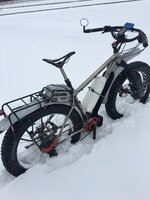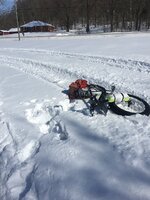@avandalen: Having extensive experience riding both types, as well as having built those bikes, I think you haven't done enough real world riding on actual bicycles as, if you did, you could not come to the same conclusion. I'll admit straight away I have absolutely zero experience with motor simulations or how to make them. I can use the Grin motor tool but only as an end user. On the other hand, I ride daily, build my bikes, and do so having learned from previous experience - and mistakes. So the next bike tends to eliminate the weaknesses of its predecessor. In my case I specifically learned the hard way that hub drives are inferior - in certain common use cases. So with that out of the way...
My daily driver commuter for some time has been until recently a 2wd geared hub bike that I ride daily on a 15.5 mile route, so 31 miles (47.9 km) total daily. this bike has a 31ah 52v battery with a 90a continuous BMS, connected to twin 35a peak controllers. So peak power on this bike is over 4kw. Max speed on flat ground with a bit of a tailwind is about 32-34 mph, with typical cruise being 30 mph. Both motors are hooked up to a single pedal assist sensor so PAS is active on the two motors and in fact I use it as a speed pedelec despite having throttles on the bike. I geared it up so I could pedal - with effort - up past the bike's max speed. Big chainrings and small cogs on a fat bike are unusual, but this bike was purpose-built for paved, flat, long streets. I have configured it in a number of ways over a period of years and at present the bike is running on smooth summer 26x4.0" tires. Pictured are fat 4.8" and smooth 2.5" (never again).


These are two spots along my commute. Note both speed limit signs are in mph not km/h, and the first pic has a separate Class 1/2 path off the road, while both have an on-road path which is where I ride. Laws in my area allow assist limits of 28 mph on that street path, and local law enforcement has no qualms whatsoever about my pedaling hard along a street at higher speeds.
![willow-1[1].png willow-1[1].png](https://forums.electricbikereview.com/attachments/willow-1-1-png.86477/)
![clovis-2[1].png clovis-2[1].png](https://forums.electricbikereview.com/attachments/clovis-2-1-png.86476/)
So with all of the above conditions, THIS is the ideal environment for a hub bike. Flat, smooth, straight. However despite my work being in this flat terrain, my actual home is in hilly coastal terrain. I took this bike to that home expecting to be able to ride it. I found that, with its exceptional power levels, it could climb anything (and anything in this case is what could be called a San-Francisco-style hills, which are the rule in that area. Nothing is flat until you get to the beach). However I also found that - given the inherent single-speed nature of the hub - it was laboring severely. It could climb, but it was obviously not happy doing it, and while I had thousands of flatland miles on the bike, if I tried to use the bike for an extended period in this terrain - all paved, mind you - it would not survive essentially forever as it was destined to in the California Central Valley. Those gears would give out eventually.
What kind of terrain is this? In discussions like this people point to pictures of horrifically steep hills, but its these sorts of long, still-fairly-steep grinds that are more typical here, and these do in the single-speed hub as the bike slowly loses momentum and lugs its sorry self moreand more slowly up that hill, turning the power it once used to rotate the motor casing, instead, to heat. I'll link this typical example so you can see it on Google Maps and look around.
Find local businesses, view maps and get driving directions in Google Maps.

www.google.com
This one is on another side of the same hill. I positioned the viewer in the middle so spin around. Not visible at the top of this hill is the sort of severe grade mid drive riders like to point to and say "you can't climb that". Well, I can but my poor singlespeed hubs with no mechanical advantages will die trying sooner, not later.
Find local businesses, view maps and get driving directions in Google Maps.

www.google.com
So, faced with this experience, I built a follow-on bike - for hills. Believe it or not this bike has the same frame as the orange one, except its in titanium this time. This bike has none of the weaknesses of the hub on the rear wheel.
I'll make this short: Problem solved. Bike goes up hills easily. For reasons that should be clear. There is still the anomaly of a front hub but I lower its output to a sweet spot of traction vs. battery drain to about 250w delivered.
Life sucks for a singlespeed hub going up a hill for the same reason it sucks for a human trying to do the same thing. Don't sell a transmission short. They serve a powerful purpose.







